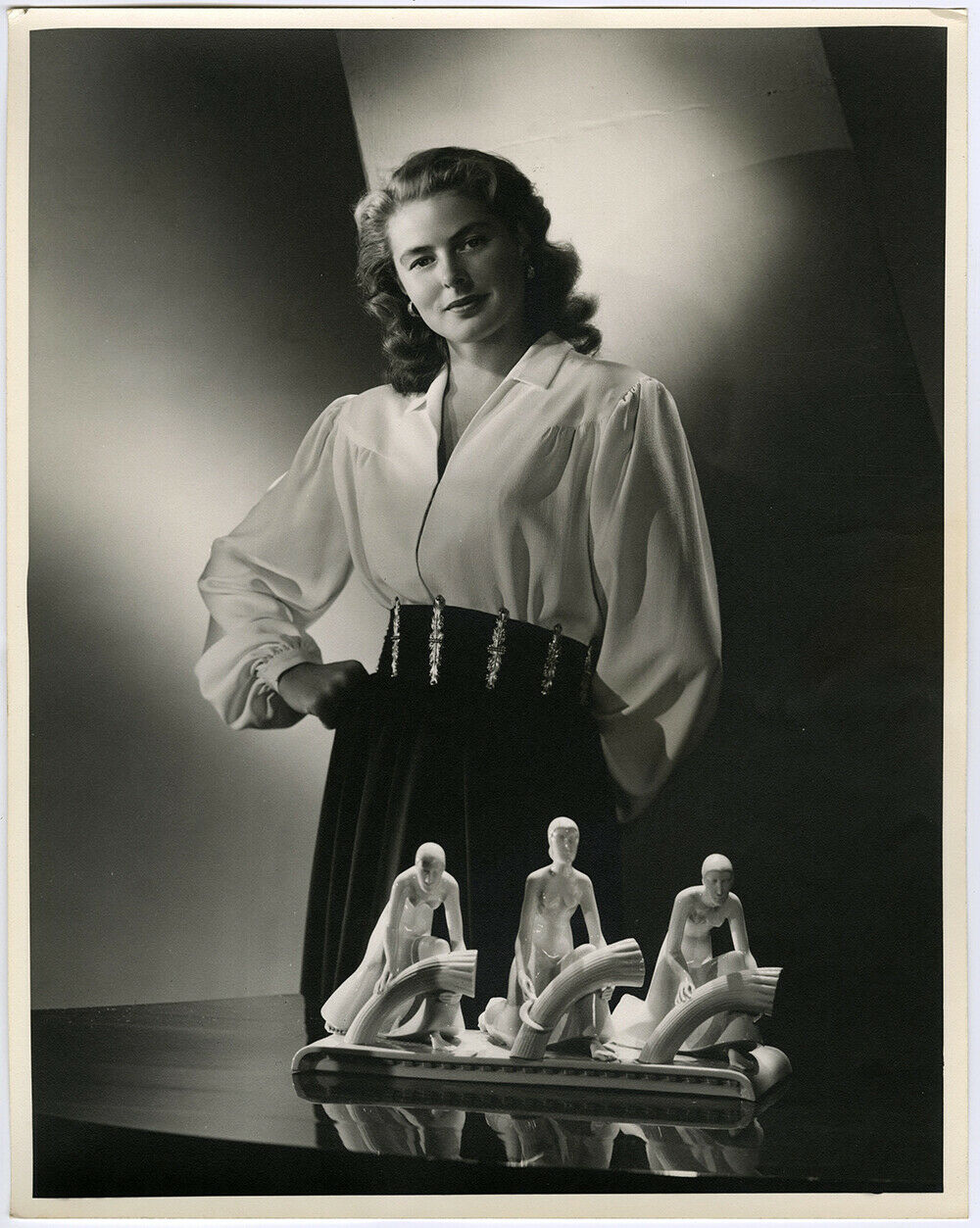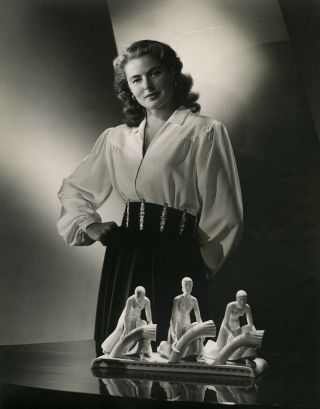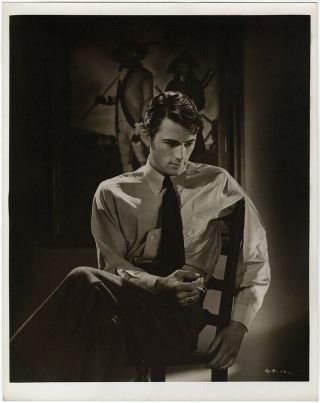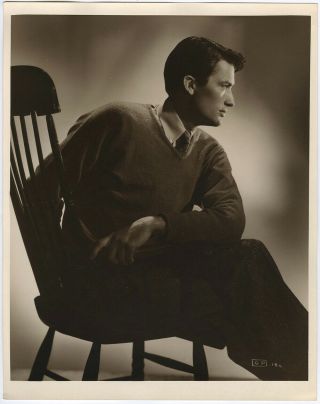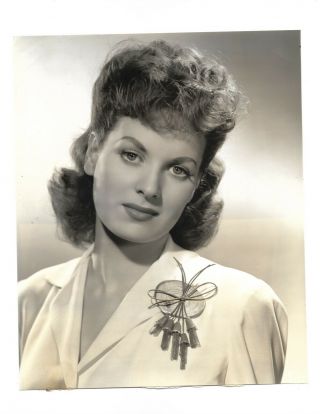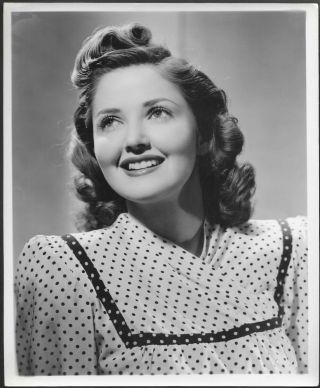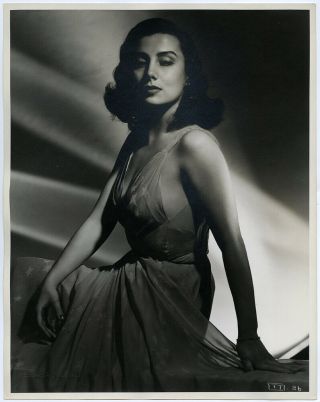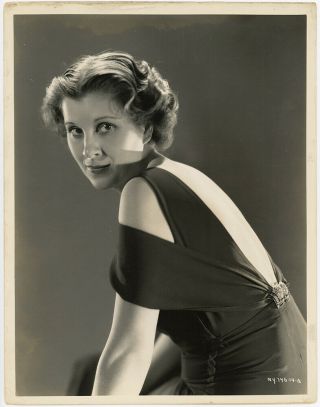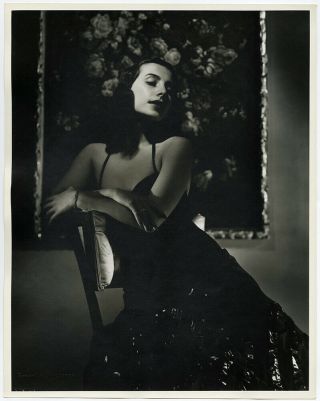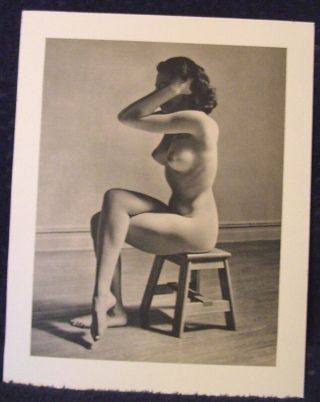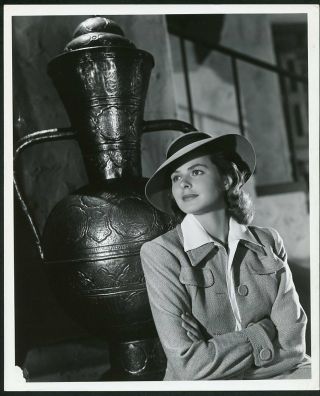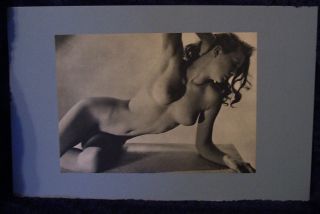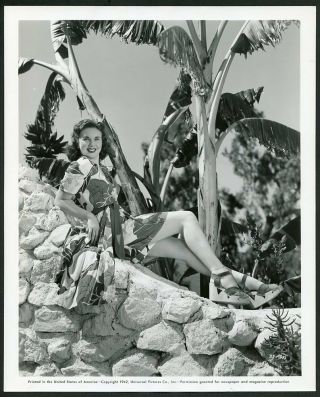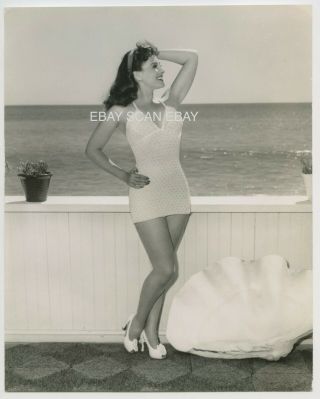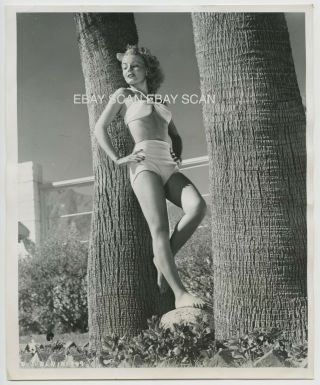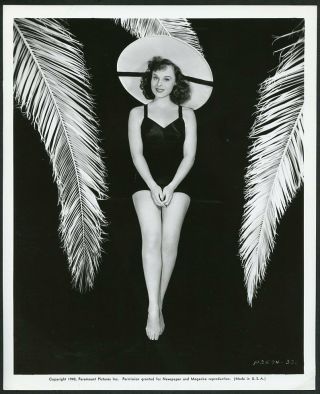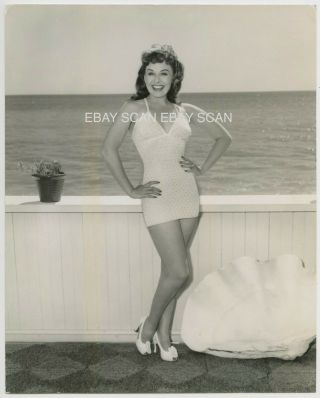Stunning 1940s Vintage Ernest A. Bachrach Ingrid Bergman Large Format Photograph
Item History & Price
Thanks to all our eBay bidders! We are honored to be your one-stop, 5-star source for vintage pin up, pulp magazines, original illustration art, decorative collectibles and ephemera with a wide and always changing assortment of antique and vintage items from the Victorian, Art Nouveau, Art Deco, and Mid-Century Modern eras. All items are 100% guaranteed to be original, vintage, and as described. Please feel free to contact us with any and all questions about the items and our p...olicies and please take a moment to peruse our other great eBay listings. All sell no reserve!
ITEM: This is a remarkable, vintage and original, 1940s large format studio portrait photograph of Golden Age of Hollywood actress iconic film legend Ingrid Bergman. Though not stamped, this is from a known sitting with photographer Ernest A. Bachrach. Bergman's natural and unpretentious beauty is on full display in this enchanting portrait with soft lighting and moody shadows that offer up a level of mystery and allure to Bergman's already intriguing charm and grace.
The Swedish actress starred in a variety of European and American films boasting such accolades as three Academy Awards, two Primetime Emmy Awards, four Golden Globe Awards, a BAFTA Award, and a Tony Award. After a decade in American films, she starred in Roberto Rossellini's "Stromboli" (1950), following the revelation that she was having an extramarital affair with the director. The affair and then marriage with Rossellini created a scandal in the U.S. that forced her to remain in Europe for several years, after which she made a successful return to working for a Hollywood studio in "Anastasia" (1956). Although she made many films for Hollywood studios in subsequent years, they were all made in Europe, and she did not film in Hollywood again until 1969. According to the St. James Encyclopedia of Popular Culture, Bergman quickly became "the ideal of American womanhood" and a contender for Hollywood's greatest leading actress. In the United States, she is considered to have brought a "Nordic freshness and vitality" to the screen, along with exceptional beauty and intelligence; David O. Selznick once called her "the most completely conscientious actress" he had ever worked with. In 1999, the American Film Institute ranked Bergman as the fourth-greatest female screen legend of classic American cinema.
Measures 11" x 14" on a matte, double weight paper stock.
Verso is blank.
CONDITION: This photograph is in fine+ condition with soft corners. Please use the included images as a conditional guide.
Guaranteed to be 100% vintage and original from Grapefruit Moon Gallery.
••••••••••••••••••••
Ingrid Bergman was one of the greatest actresses from Hollywood's lamented Golden Era. Her natural and unpretentious beauty and her immense acting talent made her one of the most celebrated figures in the history of American cinema. Bergman is also one of the most Oscar-awarded actresses, tied with Meryl Streep, both second only to Katharine Hepburn.
Ingrid Bergman was born on August 29, 1915 in Stockholm, Sweden, to a German mother, Frieda Henrietta (Adler), and a Swedish father, Justus Samuel Bergman, an artist and photographer. Her mother died when she was only two and her father died when she was 12. She went to live with an elderly uncle.
The woman who would be one of the top stars in Hollywood in the 1940s had decided to become an actress after finishing her formal schooling. She had had a taste of acting at age 17 when she played an uncredited role of a girl standing in line in the Swedish film Landskamp (1932) in 1932 - not much of a beginning for a girl who would be known as "Sweden's illustrious gift to Hollywood." Her parents died when she was just a girl and the uncle she lived with didn't want to stand in the way of Ingrid's dream. The next year she enrolled at the Royal Dramatic Theatre School in Stockholm but decided that stage acting was not for her. It would be three more years before she would have another chance at a film. When she did, it was more than just a bit part. The film in question was The Count of the Old Town (1935), where she had a speaking part as Elsa Edlund. After several films that year that established her as a class actress, Ingrid appeared in Intermezzo (1936) as Anita Hoffman. Luckily for her, American producer David O. Selznick saw it and sent a representative from Selznick International Pictures to gain rights to the story and have Ingrid signed to a contract. Once signed, she came to California and starred in United Artists' 1939 remake of her 1936 film, Intermezzo (1939), reprising her original role. The film was a hit and so was Ingrid.
Her beauty was unlike anything the movie industry had seen before and her acting was superb. Hollywood was about to find out that they had the most versatile actress the industry had ever seen. Here was a woman who truly cared about the craft she represented. The public fell in love with her. Ingrid was under contract to go back to Sweden to film Only One Night (1939) in 1939 and June Night (1940) in 1940. Back in the US she appeared in three films, all well-received. She made only one film in 1942, but it was the classic Casablanca (1942) opposite Humphrey Bogart.
Ingrid was choosing her roles well. In 1943 she was nominated for an Academy Award for her role in For Whom the Bell Tolls (1943), the only film she made that year. The critics and public didn't forget her when she made Gaslight (1944) the following year--her role of Paula Alquist got her the Oscar for Best Actress. In 1945 Ingrid played in Spellbound (1945), Saratoga Trunk (1945) and The Bells of St. Mary's (1945), for which she received her third Oscar nomination for her role of Sister Benedict. She made no films in 1947, but bounced back with a fourth nomination for Joan of Arc (1948). In 1949 she went to Italy to film Stromboli (1950), directed by Roberto Rossellini. She fell in love with him and left her husband, Dr. Peter Lindstrom, and daughter, Pia Lindström. America's "moral guardians" in the press and the pulpits were outraged. She was pregnant and decided to remain in Italy, where her son was born. In 1952 Ingrid had twins, Isotta and Isabella Rossellini, who became an outstanding actress in her own right, as did Pia.
Ingrid continued to make films in Italy and finally returned to Hollywood in 1956 in the title role in Anastasia (1956), which was filmed in England. For this she won her second Academy Award. She had scarcely missed a beat. Ingrid continued to bounce between Europe and the US making movies, and fine ones at that. A film with Ingrid Bergman was sure to be a quality production. In her final big-screen performance in 1978's Autumn Sonata (1978) she had her final Academy Award nomination. Though she didn't win, many felt it was the most sterling performance of her career. Ingrid retired, but not before she gave an outstanding performance in the mini-series A Woman Called Golda (1982), a film about Israeli prime minister Golda Meir. For this she won an Emmy Award as Best Actress, but, unfortunately, she did not live to see the fruits of her labor.
Ingrid died from cancer on August 29, 1982, her 67th birthday, in London, England.
- IMDb Mini Biography By: Denny Jackson and naim81
••••••••••••••••••••
Ernest A. Bachrach, By: Mary Mallory
Hollywood’s motion picture still photography defined sophisticated style, shaped personas and created the iconic image of “a movie star” as we know it today. The photographers’ dramatic lighting, dynamic compositions, artful negative retouching and artistic eyes influenced the American public’s perceptions of celebrities and their personalities. Stars were defined as sexy, glamorous, thoughtful, foreboding, all through the scintillating camerawork of these often unsung and forgotten men.
While photographers such as George Hurrell, Ruth Harriet Louise, Clarence Sinclair Bull, Lazslo Willinger and Eugene Robert Richee came to be recognized for their style as well as their artistic sensibilities, RKO’s chief photographer, Ernest Bachrach, gained fame for taking quality portraits that fitted whatever style was requested by art directors or studio publicity chiefs. His discerning eye easily captured the personal essence of the stars he shot, the most important element of a first-rate photographic image. As John Kobal quotes him in his book, “The Art of the Great Hollywood Portrait Photographers, ” “Portraiture is very closely akin to cinematography. The cinematographer has very little need for accessories in the making of close-ups; all he needs is a face and some lights and shadows. And that is all the portrait artist needs. Occasionally — but only occasionally — minor props are useful.”
Ernest Bachrach was born Oct. 20, 1899, in New York, and his early years are mostly unknown, though he did sign up for duty in World War I, starting his service at New York’s Ft. Slocum.
By the early 1920s, he was a stillsman for Famous Players-Lasky at their Astoria, N.Y., studio. John Kobal describes how Gloria Swanson came to admire Bachrach’s work as he shot stills for her New York films. Photographer Robert Coburn told him that for Swanson, “There was no other photographer in the world.”
When Swanson formed her own production company in 1926 and returned to Hollywood, she hired Bachrach to shoot portraits and stills for her films, including “Queen Kelly” (1928), “Sadie Thompson, ” (1928), and “The Trespasser” (1929). After Swanson’s company folded, RKO put him in charge of their newly created portrait gallery, where he would remain for most of his career.
As David Shields relates in his book, “Still: American Silent Motion Picture Photography, ” Bachrach mostly shot stars in full figure before cropping and blowing up images to create head shots, busts, and the like, as did several of his contemporaries like Max Munn Autrey, Ruth Harriet Louise and Jack Freulich. Bachrach focused on capturing expression and thought in his portraits, shaping them to suit whatever a particular medium or outlet required. His images seem alive with possibility as a result. His easygoing, friendly personality and disciplined style endeared him to stars and crew, creating a happy work environment, where his staff called him “Ernie.” His disposition and personality created a loyal, steady work force, including photographers Gaston Longet and Alexander Kahle.
While at RKO, Bachrach shot many of its outstanding stars, including Fred Astaire, Irene Dunne, Ginger Rogers and Katharine Hepburn. He connected particularly with Hepburn, capturing her intelligence, poise and flair in expressive photographs. She comments in Kobal’s book how Bachrach and other stillsmen covered flaws and faults in many women’s faces, creating goddesses out of sometimes ordinary faces.
Bachrach sometimes thought that photographers, along with the studios pushing them to turn out portraits, settled for pretty images that failed to firmly represent a star’s essence or individuality. He described in a 1932 article for American Cinematographer called, “Personality and Pictorialism in Photography, ” what he considered quality portraiture: “A primarily pictorial representation of that person’s personality, made by means of photography.”
Bachrach continually sought to improve his craft, shooting independent work to develop his skills in all areas of photography. Hollywood Reporter stated in its May 3, 1933, issue on his innovation of setting portraits on black mounting “unusually artistic.” He received several awards for his outstanding work, including the International Award at the 1933 Century of Progress Exposition in Chicago for “Finest portrait work in the world.” The Artists and Fellows of the Royal Photographic Society awarded him a diploma for his “achievement in exceptional graphic studies” at the Fair.
The artist sought to inform and educate his colleagues and the public in lighting, shooting and composing excellent photographs by writing articles for such magazines as American Cinematographer, International Photographer, Popular Photography and Silver Screen. In the July 1939 edition of Silver Screen, Bachrach noted that the first question a photographer should pose to his sitter was, “To whom are you giving it?” Photographs for parents, love interests, or jobs should all be lit and shot differently. Some of his articles focused on shooting for face shapes and body shapes, as well as technical aspects.
Besides shooting portraits, Bachrach often made time to shoot stills for important or artistic RKO films, such as “King Kong, ” “Little Women, ” “Sylvia Scarlett, ” “Citizen Kane, ” “The Secret Fury, ” “The Set-Up” and ‘Holiday Affair.”
Bachrach proudly served in various capacities for Local 659, the Cameraman’s Union, serving for years on its Executive Committee and various committees. He helped establish a cameraman’s salon to provide further opportunities in bettering their skills.
Outside of work, Bachrach focused his shooting skills as the leader of RKO’s crack rifle shooting team, composed of members of the photographic staff. The disciplined shooters placed 13th out of 133 teams in the 1936 United States small bore championship series.
Besides painting with light while shooting portraits, Bachrach also dabbled in actual painting, practicing the discipline of composing art true to life with oils and watercolors as well as chemicals, silver, and light.
By the late 1930s and early 1940s, Bachrach sometimes traveled to the East Coast to shoot portraits or stills for films. While traveling, he often visited with magazine art directors and editors to discern their needs for illustrating articles and covers. He also found time to travel to San Francisco “to make portraits of Katharine Cornell and her troupe in Rose Burke, ” per the Jan. 22, 1942, Variety.
When Local 659 organized a Stills Show with the Academy of Motion Picture Arts and Sciences in the 1940s, Bachrach often achieved recognition for his outstanding work. The photographer won certificates and first-place awards in 1942 and 1943. In 1947, Bachrach cleaned up at the last stills show, winning two first-place and two second-place awards, and the John Leroy Johnston Trophy for most popular still exhibited in the CBS Columbia Square foyer exhibit: an image of Rhonda Fleming superimposed on a human eye.
Bachrach found solace in work after his wife, Rae, died in 1949, staying busy writing articles, making portraits, and serving his union.
In October 1954, Bachrach retired from RKO after 25 years of work to go freelance and enjoy a little free time. He shot stills for “Around the World in 80 Days” and “Run of the Arrow, ” among others.
Ernest Bachrach passed away March 24, 1973, virtually forgotten by the film community. Thanks to the work of photography scholars like John Kobal and Mark Vieira in the 1980s-2000s, his outstanding skills are once again highlighted galleries, articles and books. While not as famous as photographers like George Hurrell, Ruth Harriet Louise, or Clarence Sinclair Bull, Ernest Bachrach ranks as their equal in creating elegant, iconic portraits defining stars’ personas to legions of movie fans around the world.
— Biography By: Mary Mallory c/o The Daily Mirror
••••••••••••••••••••



